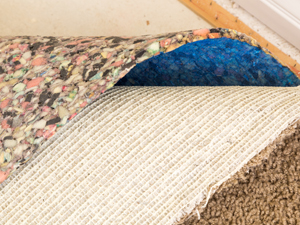Most people pay more attention to carpet than they do to the carpet padding underneath. But did you know that padding can play an integral part in the appearance and life expectancy of your carpet?
What’s wrong with cheap padding?
Carpet padding acts as a shock absorber — and not just for your feet. It eases stress from foot traffic on the carpet’s fibers and backing, helping protect them from premature wear. Cheap padding works like a charm when it is first installed, but it quickly becomes compressed or breaks apart, resulting in premature wear of the carpet. Poorly-manufactured padding can also cause a carpet to wrinkle, buckle, and even void the carpet manufacturer’s warranty.
How to Select Quality Carpet Padding
Check your carpet manufacturers’ warranties, which come with specific recommendations for padding, because the most appropriate padding for one carpet may not be suitable for another type of carpet. For example, the industry standard for padding thickness is 1/2 inch for residential carpet padding, but low-pile carpets, such as Berber, or commercial carpeting for high-traffic should be no more than 3/8 of an inch.
It is also best to look for padding with a moisture barrier and anti-microbial protection to inhibit mold, mildew, and bacteria.
The Key to Long-Lasting Carpet and Padding
Regular vacuuming and periodic professional carpet cleaning will help preserve the life of your carpet and padding. When spills or pet accidents occur, use paper towels or a white absorbent cloth towel to soak up the moisture from carpeting before it has a chance to move into the padding. Otherwise, that portion of the padding may need to be replaced.
A consistent maintenance routine will not only keep your carpet looking its best for a longer period of time, but it will help protect your investment and save you money in the long run.
This is one of a series of articles written and published on behalf of Stone and Tile PRO Partners.

